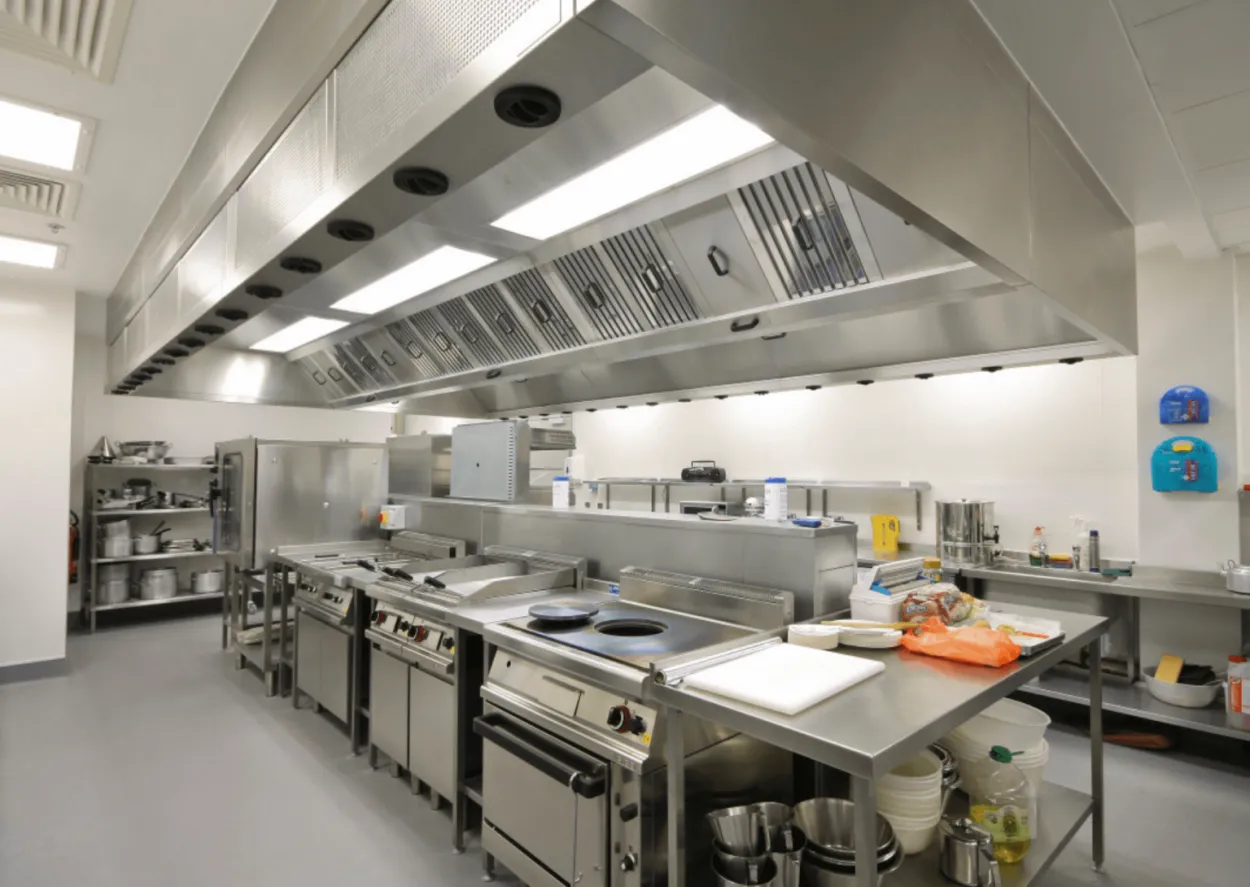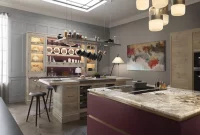The efficient office kitchen is crucial for maximizing productivity. A well-designed space promotes collaboration, encourages employees to take breaks, and provides easy access to nourishing food and beverages. This article explores key design elements that create an environment conducive to work and enhance overall efficiency.
Compact Kitchen Designs for Offices
In today’s modern workplaces, office kitchen spaces have become an essential component for promoting productivity and fostering a positive work environment. Designing a compact yet functional kitchen can greatly contribute to the efficiency of an office. Below are some key considerations to keep in mind when creating a compact kitchen design for offices.
Maximizing Space:
Optimizing the available space is crucial when designing a compact office kitchen. Consider utilizing vertical space by installing shelves or cabinets above countertops to store utensils, plates, and cups. This helps to keep the area clutter-free and provides easy access to essentials.
Efficient Appliances:
Choosing the right appliances is essential for a compact office kitchen. Look for space-saving appliances that are multifunctional, such as combination microwave-convection ovens or compact under-counter refrigerators. These appliances can help save valuable space while still providing necessary functionality.
Smart Storage Solutions:
Utilize clever storage solutions to make the most of the available space. Invest in organizers, racks, and drawer inserts to efficiently store cutlery, small appliances, and pantry items. Utilizing wall-mounted storage for spices and utensils can also free up valuable counter space.
All-in-One Workstations:
A compact office kitchen can benefit from incorporating all-in-one workstations. These multifunctional units can combine a sink, countertop, and storage compartments, allowing employees to prepare meals, wash dishes, and store utensils in one centralized area.
Comfort and Ergonomics:
Consider creating comfortable seating areas within the kitchen space, encouraging employees to take breaks and socialize. Ergonomic chairs and tables are important to support proper posture and help prevent fatigue during meal times.
Aesthetics and Lighting:
Choosing a clean and minimalist design for the kitchen can help create a spacious and inviting atmosphere. Incorporating natural lighting through windows or skylights can enhance the overall ambiance and make the space feel airy and energizing.
Encouraging Healthy Choices:
Lastly, consider promoting healthy eating habits by providing easy access to fresh fruits, vegetables, and healthy snacks. This can be achieved by setting up a designated area for a small refrigerator or a snack bar stocked with nutritious options.
Smart Storage Solutions
In order to create an efficient office kitchen that promotes productivity, it is essential to design a space that incorporates smart storage solutions. A clutter-free and organized kitchen not only enhances the aesthetic appeal but also improves functionality and overall workflow within the office environment.
1. Utilize Vertical Space
Make the most of the available space by utilizing vertical storage options. Install wall-mounted shelves or cabinets to store kitchen essentials such as coffee cups, plates, and cutlery. This not only saves valuable counter space but also makes items easily accessible.
2. Labeling and Categorization
Create a system for labeling and categorizing items to ensure easy identification and quick retrieval. Use clear containers or bins to store ingredients, snacks, or office supplies. This eliminates the need for unnecessary searching and minimizes wasted time.
3. Modular Cabinets and Drawers
Invest in modular cabinets and drawers that can be customized to fit specific office kitchen needs. These flexible storage solutions offer the ability to adjust shelf heights, add dividers, or even incorporate built-in organizers. This ensures that every inch of space is utilized efficiently.
4. Consider Multifunctional Furniture
Maximize functionality in the office kitchen by incorporating multifunctional furniture pieces. For instance, choose a table with built-in storage compartments or a kitchen island with integrated shelves or drawers. This reduces the need for additional storage units and optimizes space.
5. Implement Visual Organization Techniques
Implement visual organization techniques such as color coding or using transparent containers. This not only adds a touch of style but also enhances the overall efficiency of the office kitchen. Visual cues help employees quickly locate items and maintain a neat and organized space.
By incorporating these smart storage solutions in the design of your office kitchen, you can create a space that promotes productivity and efficiency. A well-organized and clutter-free environment allows employees to focus on their tasks without unnecessary distractions.
Easy-to-Clean Surfaces
When designing an efficient office kitchen, one of the key factors to consider is the ease of cleaning. A clean and hygienic environment is essential for both employee well-being and productivity. Here are some easy-to-clean surface options to incorporate into your office kitchen design:
1. Stainless Steel Countertops
Stainless steel is not only durable and stain-resistant but also highly resistant to bacteria growth. It is an excellent choice for countertops in a busy office kitchen as it is easy to wipe clean and does not require extensive maintenance.
2. Glass Backsplash
A glass backsplash not only adds a sleek and modern design element to the kitchen but is also easy to clean. Unlike other materials such as tiles or bricks, glass does not have grout lines where dirt and grime can accumulate.
3. Seamless Flooring
Opt for seamless flooring options like vinyl or linoleum that are easy to clean and maintain. These materials do not have any joints or seams where dirt can get trapped, making them ideal for a high-traffic office kitchen.
4. Laminate Cabinetry
Laminate cabinetry is not only durable but also resistant to stains and easy to wipe clean. Avoid materials like wood, which can be easily damaged by spills or stains and require more maintenance.
5. Non-Porous Surfaces
Choose non-porous materials for countertops, sinks, and other surfaces, as they resist staining and are easy to clean. Examples include quartz, solid surface, or porcelain, which require minimal effort to maintain their cleanliness.
By incorporating these easy-to-clean surfaces into your office kitchen design, you can create a space that promotes cleanliness, reduces the risk of contamination, and enhances productivity among employees.
Energy-Efficient Appliances
In today’s fast-paced world, efficiency is key in every aspect of our lives, including the workspace. When it comes to designing an efficient office kitchen, choosing energy-efficient appliances is crucial. These appliances not only help reduce energy consumption but also contribute to a more sustainable and eco-friendly environment.
The Benefits of Energy-Efficient Appliances
Investing in energy-efficient appliances for your office kitchen can yield various benefits. Firstly, they consume less energy compared to conventional appliances, resulting in lower electricity bills. This can help your business save money in the long run.
Secondly, energy-efficient appliances have a reduced impact on the environment. They consume less energy, which means fewer greenhouse gas emissions that contribute to climate change. By using these appliances, your office can actively participate in reducing its carbon footprint.
Choosing Energy-Efficient Appliances
When selecting energy-efficient appliances for your office kitchen, it is essential to consider their energy rating. Look for appliances with high energy efficiency ratings, such as those labeled with the ENERGY STAR symbol. These appliances have been tested and meet strict energy efficiency standards set by the Environmental Protection Agency.
Additionally, opt for appliances with advanced features such as automatic shut-off timers and power-saving modes. These features ensure that the appliances are not consuming unnecessary energy when not in use.
Recommended Energy-Efficient Appliances for Office Kitchens
Here are some energy-efficient appliances that are highly recommended for office kitchens:
- Energy-efficient refrigerators: These appliances are designed to use less energy while keeping food and beverages cool.
- Induction cooktops: They heat food faster and are more energy-efficient compared to conventional gas or electric stoves.
- Energy-efficient dishwashers: These appliances use less water and energy compared to regular dishwashers, saving both resources and money.
- LED lighting: Switching to LED light bulbs can significantly reduce energy consumption in the office kitchen.
- Smart power strips: These power strips automatically turn off appliances when they are not in use, preventing phantom energy usage.
In conclusion,
By selecting energy-efficient appliances for your office kitchen, you can create an environment that promotes productivity while reducing energy consumption and costs. Consider investing in these appliances to make your office kitchen more efficient and environmentally friendly.
Functional Layouts
In today’s modern office environments, the design and layout of the office kitchen play a crucial role in promoting productivity among employees. An efficient office kitchen can contribute significantly to creating a positive work culture, fostering collaboration, and enhancing overall employee satisfaction.
Optimizing Space and Arrangement
An office kitchen with a functional layout maximizes available space and ensures smooth traffic flow. It is essential to place appliances, cabinets, and workstations strategically to minimize unnecessary movement. By organizing items logically, employees can easily locate and access what they need, reducing time wasted searching for utensils or ingredients.
Promoting Cleanliness and Organization
A cluttered and disorganized kitchen can hinder employee productivity. Implementing storage solutions such as labeled containers, shelves, and drawers can help keep the kitchen tidy and ensure everything has its designated place. Regular cleaning schedules and clear communication about kitchen etiquette are also essential to maintain cleanliness and hygiene.
Multifunctional Workspace
An efficient office kitchen should be designed as a multifunctional space that accommodates various activities. It should provide areas for employees to prepare their meals, eat, and relax during breaks. Including comfortable seating options, tables with sufficient workspace, and amenities like coffee machines or microwaves can enhance the overall experience for employees.
Creating a Welcoming Atmosphere
The office kitchen should be more than just a functional space; it should also be inviting and comfortable. Incorporating elements such as natural lighting, plants, or artwork can enhance the ambiance and make the environment more pleasing. By creating a welcoming atmosphere, employees are more likely to utilize the kitchen and take breaks, which can refresh their minds and improve productivity.
In conclusion, designing an efficient office kitchen requires careful consideration of space utilization, organization, functionality, and ambiance. The layout should facilitate easy movement, encourage tidiness, provide multifunctional spaces, and create a positive environment. By prioritizing these aspects, companies can cultivate a productive and enjoyable office kitchen that contributes to overall employee well-being and satisfaction.
Conclusion
A well-designed office kitchen can greatly enhance productivity by providing a comfortable and efficient space for employees to recharge and collaborate. Incorporating elements such as ample storage, ergonomic furniture, and smart organization can help create a conducive environment for both food preparation and social interaction. By investing in a thoughtfully designed office kitchen, companies can foster a positive work culture and promote employee well-being.




